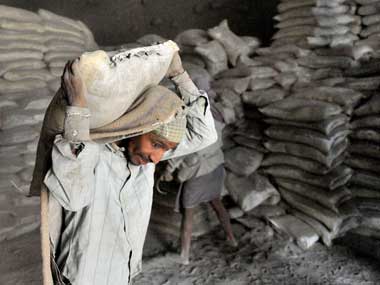Half a billion Indians were born after 1980. Since their teens, they have been citizens of a free market economy, an open and aspirational India. They will comprise the bulk of impatient voters in 2014. They are infuriated and mystified by India’s stalled economic reforms. Why, they bemoan, can’t we take bigger risks, make bolder policies? Why are we so deeply suspicious of market forces? Why, to use their Twitter lingo, are we such losers?
I can trot out reams of history to address these angry doubts. But that may be too dense and verbose. Instead here are the pithy, tortured stories of two industries-first cement, then steel-to illustrate the deep genetic fault lines of India’s economic policy apparatus.
[caption id=“attachment_1471039” align=“alignleft” width=“380”]
 Unfolding the cement story. AFP[/caption]
Unfolding the cement story. AFP[/caption]
Draconian controls on the cement industry were first clamped during the Second World War, across distribution channels, purchase prices and quotas for open market sales. It was amusing, even tragic, to see the amount of tinkering that the government did to ‘balance’ social objectives with economic growth. Behind every change in policy and prices, I could imagine the amount of lobbying and worse that must have happened!
In 1956, the State Trading Corporation was given the distribution monopoly. It was the sole importer. Purchase prices, based on plant age, technology and incentives for capacity addition, were of three kinds in 1958, made uniform in 1969, and were three-tier once again in 1979. But freight equalisation meant prices were the same across the country.
Distribution controls were partially lifted in 1966, re-imposed the following year, but again lifted partially in 1982, when quotas were introduced. Old mills could now sell a third in the open market, sick units half of their production and new units more than that.
For 40 long, crucifying years, it was a saga of a price snitch here, a distribution ban there, a partial relaxation followed by an equally whimsical roll-back, an astonishing pantomime of controls, controls and more controls. But mercifully, the government, which had choked on its micro management, began to understand how a tiny amount of decontrol had loosened the noose around its neck.
It was Tuesday, the 28th of February 1989, the customary Union Budget day. The Opposition made parliamentary history by boycotting the session. The previous day prime minister Rajiv Gandhi had accused the Opposition of ‘supporting terrorists’. Not the kind that plague the country now, but Sikh terrorists. The finance minister was SB Chavan.
He acknowledged the strides made in cement production since partial decontrol in 1982. Production had doubled to 43.5 million tonnes. Only a fifth of the production was impounded by the government at less than market rates. Imports had stopped four years before. The country was exporting cement. Chavan announced decontrol of the industry from the very next day, along with another commodity, aluminum in which the country had achieved self-sufficiency with the expansion of the state-owned company, Nalco.
But the news scarcely got any attention. In the Bombay Stock Exchange, the price of cement company ACC’s shares rose to Rs 320 on the news, but fell to Rs 296 by close of trade, and further to Rs 282 at night on fresh offerings (the stocks exchanges followed a different rhythm then).
An English newspaper, wedded to free enterprise but perhaps run by socialist editors, did not say a word about the twin decontrol. Instead, it headlined the budget as ‘Anti-poverty and pro-growth’ (was it ever anything else) and commended the finance minister for helping the Congress shed its ‘pro-rich image’ (!) by keeping the income tax exemption limit unchanged at Rs 18,000, imposing an 8 percent surcharge on those earning three times as much, and extracting Rs 100 crore a year from buyers of Maruti small cars, ’the hallmark of the affluent’.
Chavan did other things to burnish his pro-poor credentials. Being an election year, saris worth Rs 12 crore would be distributed to the poor, and an employment guarantee scheme of Rs 500 crore would be created for 120 backward districts. That scheme, in a different avatar, now has an outlay which is sixteen times as large. As long as Indian governments have money to spare, poverty will continue to grow!
Now you get it, don’t you? The more things change in India’s economy, the more they remain the same for India’s old-world politicians. This economic timidity has gotten into our genes. That’s why, to use Twitter lingo, we are such losers. And that’s why we need to elect a new generation of politicians in May.
To complete the story, ever since that fateful day in 1989 when cement was decontrolled, production has grown four times to 180 million tonnes. Though there are a large number of players, seventy percent of production is with a dozen companies. Several foreign giants have invested in India - for instance, Ambuja, which had a tenth share of the market, was acquired by Holcim, a Swiss group.
The competition watchdog has slapped some of India’s leading cement producers with a fine of more than one billion dollars to punish collusive behavior. Cement can be imported duty free. So collusion should not result in price gouging of consumers, though difficulty in getting railway rakes can create pockets where consumers are over-charged.
Today, India’s cement industry has become the second largest producer and exporter in the world. Just imagine if the industry had been decontrolled and properly regulated since the 1950s.
Next: The Steel Story
Winner of the Sanskriti Award for Journalism in 1994, Raghav has over 22 years experience in television and journalism. He founded TV18 (now Network18 Group) in 1993. Raghav is a widely admired entrepreneur and was hailed as a Global Leader of Tomorrow by the World Economic Forum. An Economics graduate from St. Stephens College, Raghav has done MBA from the University of Delhi. Raghav has also authored the book 'Superpower?: The Amazing Race Between China's Hare And India's Tortoise'.
)